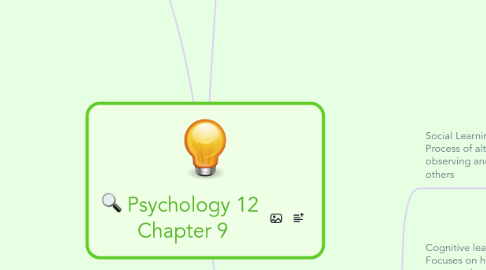
1. Discrimination the ability to respond differently to different stimuli Generalization occurs when an animal responds to a second stimulus similar to the original CS without prior training with the second stimulus
2. Mindmeister How To's.
2.1. We hope you'll have fun with MindMeister ...
2.2. Get started now!
2.3. ... and some great ideas too!
2.4. Key shortcuts
2.4.1. INS to insert (Windows)
2.4.2. TAB to insert (Mac OS)
2.4.3. ENTER to add siblings
2.4.4. DEL to delete
2.4.5. Press F1 to see all key shortcuts
2.5. Use toolbar to add ideas
2.6. Drag & Drop and double-click canvas
2.7. My Geistesblitzes
2.7.1. Check out http://www.mindmeister.com/tools
3. Classical Conditioning
3.1. 1. Always a specific stimulus (US) that elicits the desired response 2. US does not depend upon learner's response 3. Enviroment elicits response from learner
3.2. Parts of a situation
3.2.1. Neutral stimulas :
3.2.2. unconditioned stimulus (US):
3.2.3. unconditioned response (UR):
3.2.4. conditioned stimulus ( CS ):
3.2.5. conditioned response (CR):
3.3. Acquisition : classically conditioned response generally occurs gradually. With each pairing of the conditioned stimulus and the unconditioned stimulus, the conditioned response or learned response-is strengthened
3.4. Extinction conditioned response that gradually dies out Taste Aversions
4. Operant conditioning
4.1. 1. No identifiable stimulus; learner must first respond, then behaviour is reinforced 2. Reinforcement depends upon learner's behaviour 3. Learner actively operates on its environment
4.2. Reinforcers : A stimulus or event that increases be the likelihood that the preceding behaviour will be repeated
4.2.1. Primary Reinforcers
4.2.1.1. Satisfies a biological need such as hunger, thirst or sleep
4.2.2. Secondary Reinforcers
4.2.2.1. is one that has been paired with a primary reinforcer and through classical conditioning has acquired value and the ability to reinforcer
4.3. Shaping: is a process in which reinforcement is used to sculpt new responses out of old ones
4.4. Response Chains: Learned reactions that follow one another in sequence, each reaction producing the signal for the next
4.5. Aversive Control: process of influencing behaviour by means of unpleasant stimuli
4.5.1. Negative Reinforcement: increasing strength of a given response by removing or preventing a painful stimulus when the response occurs
4.5.2. Escape Conditioning: training of an organism to remove or terminate an unpleasant stimulus
4.5.3. Avoidance Conditioning: training of an organism to respond so as to prevent the occurrence of an unpleasant stimulus
4.5.4. Punishment: Form of aversive control, an unpleasant consequence occurs and decreases the frequency of the behaviour that produced it
4.5.4.1. Disadvantages --> can produce unwanted side effects like rage, aggression, and fear, which would end up into another problem --> people would learn to avoid the person delivering the aversive consequences. Children learn to stay away from parents or teachers who often punish them
5. Social Learning
5.1. Social Learning: Process of altering behaviour by observing and imitating the behaviour of others
5.2. Cognitive learning : Focuses on how much information is obtained, processed and organized (learning is concerned with mental processes, latent learning and learned helplessness)
5.2.1. Mental Processes
5.2.1.1. cognititve map: a mental picture of spatial relationships or relationships between events
5.2.1.2. latent learning: alteration of a behavioural tendency that is not demonstrated by an immediate, observable change in behaviour
5.2.2. Learned Helplessness
5.2.2.1. Condition in which repeated attempts to control a situation fail, resulting in the belief that the situation is uncontrollable
5.3. Modeling
5.3.1. behavioural modification systematic application of learning principles to change people's actions and feelings
5.3.2. Computer assister instruction (CAI) Programed instructions. Materials which are broken down into simpler units called frames.
5.3.3. Token Economies Conditioning in which desirable behaviour in reinforced with valueless objects, which can be accumulated and exchanged for valued rewards (Mrs.Aldcrofts friend (teacher) giving kids paper money so they can buy things later with the money they earn when they are being good students)
5.3.4. Self-Control Having self control means that you are aware of what you are doing. Refraining from an old bad habit, to get rid of if you have to have self control
5.3.4.1. Improving Study Habits (Something I need to work on)
